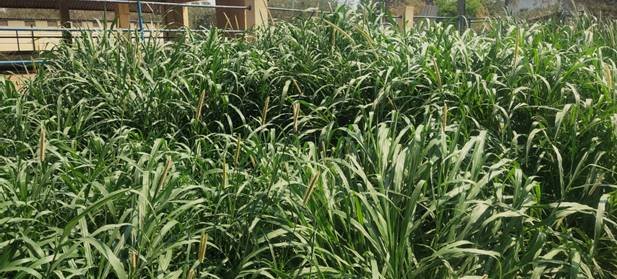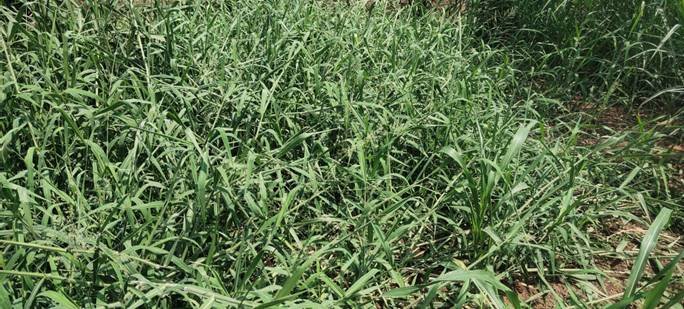CULTIVATION PRACTICES OF NON-LEGUMINOUS PERENNIAL FODDER CROPS
NAPIER BAJRA HYBRID
Napier or Elephant grass (Pennisetum purpureum) is native to tropical Africa. It is widely grown in tropical and sub-tropical areas, from sea level to 2000 m above mean sea level (AMSL). The grass is valued for its high herbage yield, competitive vigour and persistence, palatability and good herbage quality. It grows best at high temperatures. Yields are reduced with low air temperature and plants cease to grow at below 100C. It normally grows in areas with annual rainfall of over 1000 mm, but is also seen in semi – arid areas. It can withstand drought and easily recovers with onset of rain.
It’s production is higher on fertile soil but can grow on almost any soil. It cannot tolerate flooding or water logging but can grow reasonably well on drained soils.
Hybrid Napier is developed by crossing napier grass with bajra (pearl millet or candle millet).
A number of varieties are evolved. NB-21 is the earliest and popular variety. Others of recent origin include Co-1,2,3,4,5&6, IGFRI-3, APBN-1,2 (released by APAU) and Super Napier (Packchong 1) etc.
Land is thoroughly ploughed and leveled. Then it is laid into ridges and furrows with a spacing of 50 cm. Planting can also be done on flat beds.
Being a sterile hybrid, it is propagated by stem cuttings or rooted slips. Planting can be done at any time if irrigation is available except during winter months, but it is best done in February. June-July planting is preferred for rainfed conditions.
Stem cutting should have two nodes. Cuttings are made from moderately mature stems. Cuttings are placed into the soil at angle of 450 so that one node is pushed into the soil and one remains above the soil surface. The basal end should be placed down. Rooted slips are prepared from uprooting a clump, dividing it into slips with few roots and small stem portion. While planting, the root potion is placed in the loose soil and soil is compacted. It is followed by irrigation. The spacing for pure crop of Hybrid Napier is 50 x 50 cm. A spacing of 100 x 50 cm is practiced when it is intercropped with other crops, particularly hedge lucerne. This crop needs adequate irrigations. Irrigation interval can be 15-20 days during winter and 8-10 days during summer.
The average yield of green fodder is 150-250t/ha/yr with crude protein content of 8 – 9 %. NBHybrid contains good amount of oxalates and continuous sole feeding may lead to nutritional disorders. However, this problem is never felt under normal existing feeding conditions.
Inter culture twice a year helps to maintain good growth and yields. The field may be replanted with the grass after 3-4 years. When the clump becomes too large, a technique called as quartering can be practiced to reduce the size of the clump which aids in maintaining the green fodder yields. Quartering is a practice in which tillers in ¾ area of the clump are dug carefully and removed leaving tillers in 1/4 area of the clump intact.

Large and vigorous legumes capable of withstanding the competition from NBHybrid are normally used for intercropping. Hedge Lucerne (Desmanthes virgatus) can be used for intercropping in 1:1 ratio. Otherwise, intercropping with cowpea can be done after each cut by dibbling the seed in the interspaces.
Hybrid Napier is always fed in the green form or conserved as silage. It is not converted into hay because it looses the palatability. Chaffing is necessary to utilize the green fodder more efficiently.
PARA GRASS
It is a perennial with prostrate shoots freely rooting at nodes forming dense cover. It is suitable for cultivation in humid areas. It is grown in seasonally flooded valleys and lowlands and can withstand water logging and long term flooding. It cannot be grown on dry lands, in arid or semi-arid areas. It is sensitive to cold and makes little or no growth during winter months in sub-tropical regions of India.
Water-logged soils are best suited for this crop. It can be grown on sandy soils also, provided water supply is sufficient.
Seed setting is very poor in this grass. It is propagated exclusively by stem cuttings.
It can be planted at any time in South India, but June-July planting is best under rainfed conditions and February under irrigated conditions.There are no improved varieties of this grass. The field is well prepared by puddling (ploughing with standing water) and leveled. The shoots are used as planting material. Stems with 2-3 nodes are planted in 45-60 cm rows at 20 cm spacing. The stems are pressed into wet soil leaving the two ends sticking up.8-10 quintals of stem cuttings are needed for planting one hectare.
Liberal manuring is necessary for high yields. Sewage water or cattle shed washings are ideal for this crop. Or else, apply 20-25 t/ha of FYM every year. 25-30 kg N/ha is applied after each cut. Once in a year, apply 60 kg P2O5/ha for better and sustained growth. The crop needs liberal irrigations at fairly close intervals. The land should always be kept moist. Weed control is not important because of the high competitive vigour of the crop. During establishment one or two hand weedings may be given. The first cut is taken 75-80 days after planting and the subsequent cuts at 40-45 days interval. Totally 6-9 cuts can be taken in a year with an average green fodder yield of 80-100 t/ha. The grass is fed in the green form. It is not suitable for conservation either as hay or as silage. While feeding in green form, the mature culms are often rejected. So, chaffing is needed for mature grass. The grass contains lot of moisture (more than 85%) and is highly palatable, but it is low in the nutritive value with 6-8% crude protein. Though some inter cropping systems with legumes are suggested, it is widely grown as pure crop.

GUINEA GRASS
Distributed in South and Central America, West Indies, South East Asia. Introduced in India in 1793 and is the oldest among the grasses introduced in India. It is a tall, densely tufted perennial with numerous shoots arising from short rhizomes. A fully grown plant attains a height of 1.8 to 2.7 m under favourable conditions. Leaf blades are about 60 cm long and 2.5-3.8 cm broad and light green in color. The inflorescence is an open panicle, about 30cm long and 10-13 cm across.Very popular grass and widely grown in many parts of India. Thrives well in warm, moist climate. Thrives well on fertile, well drained, medium loam soils. Cannot be grown in waterlogged conditions. Land is prepared by 2-3 ploughings followed by 3-4 harrowings.

VARIETIES
Queensland common – Bunchy type growing to 150 cm height with finer leaves, stem nodes are hairy.
Makueni – Drought resistant, grows to a height of 1 m
Gatton panic – Resistant to nematode attacks.
Hamil – Tall variety (3-3.5m) of guinea grass. It is robust, smooth with dark foliage.
Coloniao Guniea – Hairless, has thick flashy stems, hence very palatable. Equally taller that of hamil.
Sabi – Possess bluish leaves, grows to a height of 1.5 m and drought resistant.
The whole clump is dug up with the roots to a depth of one foot and divided into several parts. The small slips are then used for planting usually after topping the foliage. The slips are planted 90-122 cm apart between rows and between plants. The slip rate 12,350 per hectare.
FYM of 168-224 kg/ha and 40:20:12 kg of NPK/ha should be applied in February and again in June-July. Liberal irrigation should be given immediately after planting. Irrigation interval is 10 – 15 days.
Weeding should be done once or twice during the period of establishment. First cut can be taken at 6-8 wks after planting. Fodder is palatable when the grass is 60-90 cm tall. Preferable to cut before flowering. Green fodder yield is 100 t/ha in 5-6 cuttings in a year.
It can be grown as an intercrop in orchards and other tree plantations as it can thrive in shade.
| Cultivation practice | Hybrid bajra Napier | Paragrass | Anjangrass | Guinea grass | Rhodes grass |
| Varieties | APBN-1, CO-1, CO-4, CO-5, Phule jayanth, BNH-10 | — | IGFRI-3813 | Hamili, Makuni, DGG-1 | |
| Soils | All types of soils | Water stagnated soils, black soils | Well drain soils, light and black soils ,grass lands and waste lands | Well drain soils, light and black soils | Well drain soils, light and black soils |
| Sowing time | Kharif : June-Aug, Summer: Jan-feb | Kharif : June-Aug, Summer: Jan-feb | June -july. | Rainy season | June- july |
| Seed rate kg/ac | 32000 two node stem cuttings or root slips per acre | 20000 rooted slips | 3-4kg seed for broad casting | 2-2.5 kg seed for broad casting | 1.5 to 2kg seed |
| Spacing | 600 X 60 cm | 35 X 35 cm | 50 X 50 cm | 50 X 50 cm | 50 cm |
| Recommended dose of fertilizers(NPK kg per acre) | FYM 10 tones 20:20:12 NPK | FYM 5-10 tones Apply 20kg nitrogen after every cut | FYM 5-10 tones Apply 20kg nitrogen after every cut | FYM 5-10 tones Apply 20kg nitrogen after every cut | FYM 5-10 tones Apply 20kg nitrogen after every cut , gypsum in saline soils |
| Apply 20kg nitrogen after every cut | |||||
| Harvesting time | 1st cut 70-90 days after sowing subsequent cuts 45 DAS | 1st cut 70 days after sowing subsequent cuts 40 DAS | 1st cut 80-90 days after sowing subsequent cuts 45 DAS | 1st cut 70-50 days after sowing subsequent cuts 40 DAS | 1st cut 60 days after sowing subsequent cuts 40 DAS |
| Green fodder yield tonnes/ acre | Total 6-8 cuts per acre per year, | Total 10-12 cuts per acre per year 60 – 80tonnes per acre | 16 tonnes in 4-6 cuts per year per acre | 80-100tonnes | 6-8 tonnes |
| 120 – 150 tonnes per acre | |||||
| Other information | Susceptible to Cold (exept super napier) Due to present of oxalates it should be mixed with other grass | *Crude protein content:3-5% | Drought resistance Suitable for wasteland and grass lands (life span 10-15years) Crude protein content:5-6% | Comes well in shade (inter crop in orchards) condition, | Suitable in saline soils |
| *Crude protein content:9-10 % | Crude protein 6-8% |
